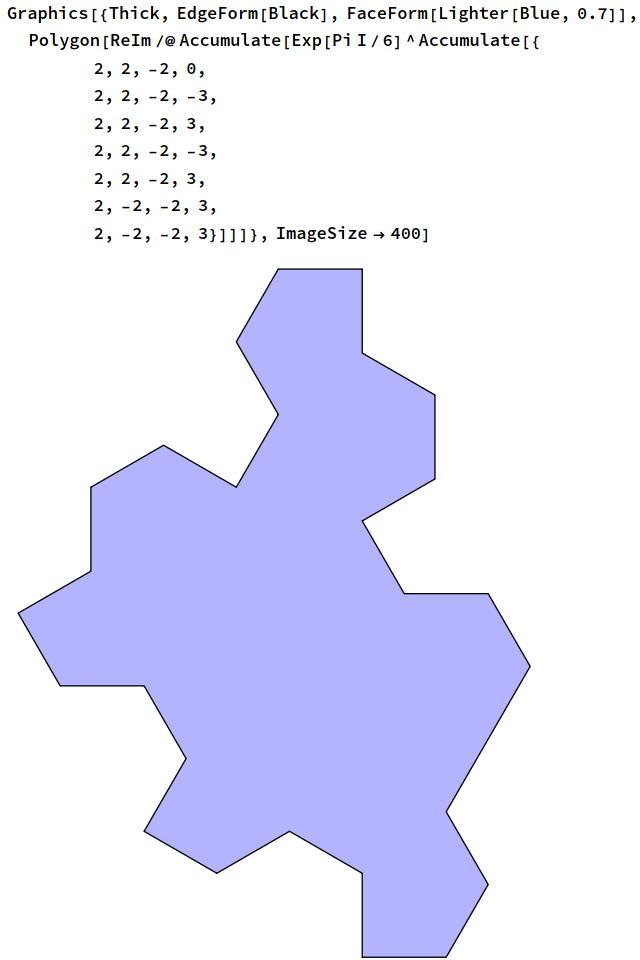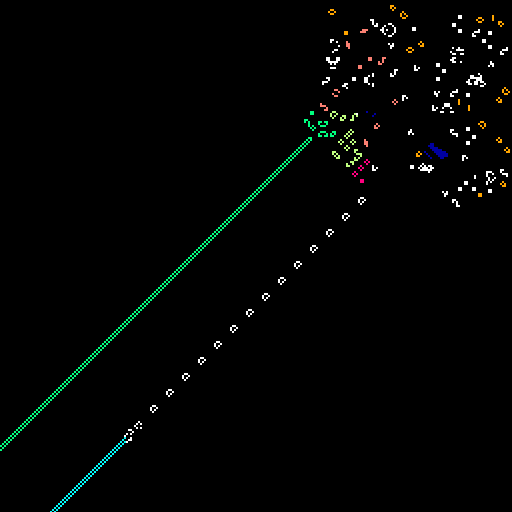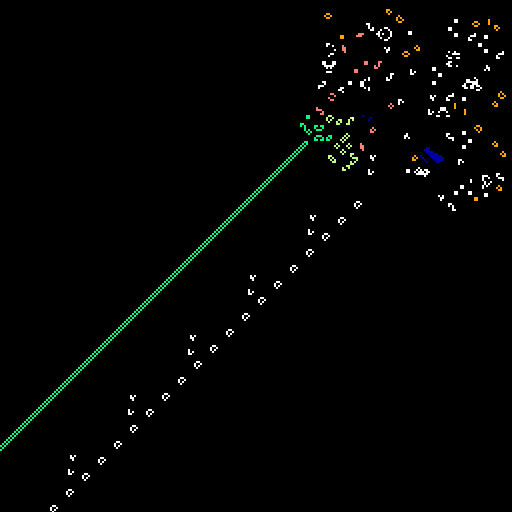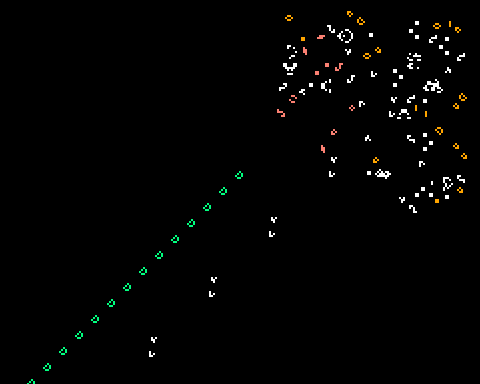Miscellaneous discoveries
Complex Projective 4-Space 2023-07-24
Soon after the previous post announcing the discovery of an aperiodic monotile by Smith, Myers, Kaplan, and Goodman-Strauss, the same authors published a second aperiodic monotile which has the property that all of the tiles are of the same orientation: reflections are not needed.
This new tile, dubbed Spectre, is Tile(1,1) from the previous paper but with perturbations on the edges to enforce that all tiles are similarly oriented. The authors provide a curvilinear realisation, but there is also an equilateral polygonal realisation with 28 edges (two of which are parallel, so this is equivalently a 27-gon where one edge is twice as long as the remaining 26 edges):

Unlike their previous aperiodic monotile, the ‘hat’, this monotile cannot be described as the union of tiles of an Archimedean dual tiling. It does, however, admit the above description where every vertex lies in the ring of integers of the 12th cyclotomic field.
Omniperiodicity
In other news, Conway’s Game of Life has now been proved omniperiodic (for every positive integer n, there exists an oscillator of period n), with the recent discoveries this month of the remaining two unsolved periods, 19 (by Mitchell Riley) and 41 (by Nico Brown).
The proof of omniperiodicity involves witnesses for every period up to 42, beyond which adjustable glider loops handle every period from 43 upwards. These witnesses are listed on the status page.
Tetrational diehard progress
In the same cellular automaton, there has been a significant improvement in terms of engineering a ‘diehard’ (pattern that eventually fully disappears after a long number of generations) in a bouncing rectangle of area < 10000. Last year, we mentioned that Pavel Grankovskiy had engineered a diehard with a lifespan exceeding:
10^10^10^10^10^10^10^10^10
Note that this is a tetrational (iterated exponential) tower of height 9. In the last few days, various authors have increased the height of this tower considerably: Pavel Grankovskiy and a pseudonymous forum poster (toroidalet) improved the height to 15 before, in the space of a few hours, it explosively increased to 25, then 35, then 310, then 320, then 363, then 13131937954518, and now the record stands at 1.1038 × 10^1046.
The record-holder is really rather complicated and fits in a 109 × 91 box:

The pattern has been colour-coded vaguely in terms of function. The dense blobs of ‘spacedust’ are the results of SAT-solver-based predecessor searches to squeeze the pattern into this box. After running it for 120 generations, the pattern is less inscrutable:

Travelling to the southwest is a c/5 diagonal spaceship (in white) flanked by two c/4 diagonal ‘boatstretchers’ (one in mint green, and one in duck-egg blue). Most of the junk inside the body of the configuration exists as a delay mechanism to prolong the burning of the duck-egg blue fuse for as long as possible (more than eleven thousand generations). At generation 11880, we see that the fuse has commenced burning to leave a trail of loaves:

The fuse burns more quickly than the boatstretcher can extend it, and by generation 16000, it has completely burned to leave behind a trail of 478 loaves. Pairs of gliders produced by the body of the configuration head towards the receding c/5 diagonal spaceship:

When they reach the c/5 diagonal spaceship, a block is produced, and the pairs of gliders proceed to pull the block backwards, one cell at a time, until it collides with the southwesternmost loaf, cleanly annihilating it. If the distance between the spaceship and the loaf is N, then it takes 116N generations to pull the block back to the loaf (the gun is period-120, but the Doppler effect means the block is pulled with period 116), and then another 484N generations for the glider stream to catch up with the spaceship. As such, the spaceship has receded by a distance of 600N/5 = 120N, so it is 121 times further away than it was before.
This process repeats, with each of the 478 loaves multiplying the delay by a factor of 121. A few more factors of 121 are consumed by the lemon-yellow junk in the body of the mechanism, at which point the mint-green fuse is ignited.
This second fuse burns much like the first fuse, except now the scale is much larger: instead of producing 478 loaves, it produces 1.1038 × 10^1046 loaves. More precisely, the number of loaves is expressible using the following Python expression:
int('306'+'377400'*162+'38'+'78'*13+'56',11)Here is the northeast corner of the pattern after the fuse has been ignited, simulated using a hashlife implementation. It took approximately 16 minutes to run the pattern for the 2^3480 generations necessary to reach this stage:

We have a second block-pull tractor beam mechanism, precisely reflected across the c/5 diagonal spaceship’s line of symmetry; this one is exponentially sparse (therefore not visible in the picture above), and so the times at which the loaves are removed are tetrationally sparse. Consequently, the time for the first n loaves to be destroyed is a power tower of height n. After a time expressible only as a power tower of height 1.1038 × 10^1046, all of the loaves are destroyed, and the entire mechanism cleanly self-destructs (with the help of the salmon and beige cells) to leave zero live cells.
Note that whilst hashlife is capable of simulating the 2^3480 generations necessary to burn the second fuse, it cannot handle the tetrational part of the mechanism; instead, this analysis relies on bespoke mathematical analysis of the behaviour of the pattern.
More ambitious plans
This is still at a very low rung on the fast-growing hierarchy: we would need an extra c/5d spaceship and corresponding pair of tractor beams for every 2 levels of the hierarchy, and even then we are restricted to primitive-recursive functions. If we dispense with the 10000-cell bounding box limitation, there are plans to build self-destructing Turing machines with extremely long lifespans. One of those plans involves a function that grows so quickly that it cannot be proved total in Peano arithmetic, based on the ‘primitive sequence system’. But that is a special case of something even more powerful, namely…
Bashicu Matrix System proved well-ordered
…the Bashicu Matrix System.
A very exciting paper by Samuel Vargovcik proves the well-orderedness of a conjectured system of ordinal notations, the Bashicu Matrix System, named after its discoverer. Ordinals (up to some large but as-yet-undetermined countable ordinal) are represented as matrices of natural numbers.
The order type of height-1 matrices (‘primitive sequence system’) is ε_0, same as the Kirby-Paris hydra; the order type of height-2 matrices (‘pair sequence system’) is Buchholz’s ordinal; beyond that, the exact order types are unknown and were only proved well-ordered by Vargovcik’s recent paper.
This is particularly noteworthy as other systems of ordinal notations, such as those of Buchholz, are bounded by much smaller ordinals (e.g. TFBO). The Bashicu Matrix System gives a very concise tabular representation for ordinals up to (some very large ordinal, far beyond TFBO); for example, the Bachmann-Howard ordinal is (according to this page) representable as the Bashicu matrix ((0, 0), (1, 1), (2, 2)), read in column-major order. The supremum of all height-2 matrices is the height-3 matrix ((0, 0, 0), (1, 1, 1)), which therefore corresponds to Buchholz’s ordinal.